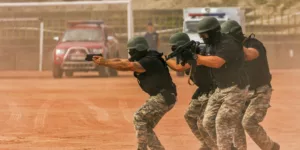Ballistic-resistant armor is paramount for protecting the lives of all who wear them. At one point in time, such armor was considered a “luxury.” Worn only by higher-income officers and agencies that had the funds. Combination armor typically protects against both ballistics and stab/slash attacks. However, they tend to be more expensive. Here a few things you need to know while considering which body armor to buy.
1. Industry Performance Standards
Ballistic-resistant armor must meet the National Institute of Justice (NIJ)’s standard—which is 0101.06 and 0101.07—for body armor. Armor that doesn’t meet these standards should not be considered. Meeting performance standards is of the utmost importance – the pricing factor of such armor should not be taken into consideration, as the safety of your workers trumps price.
2. Wearing Armor
Will your tactical gear be worn covertly or overtly? Does your agency require pockets in your workers’ line of duty? How do you prefer the armor to be fastened? Do you need them to be waterproof? Asking these critical questions goes a long way towards selecting the armor that’s right. They will build the foundation for ensuring that the armor you select can easily be worn and maneuverable to meet the daily demands of your officers and personnel.
3. Threat Level
You undoubtedly know the unwritten rule to wear the level of armor that would protect you against your own weapon. However, you also know to purchase armor on the grounds of encountering higher levels of threats, such as for patrol work. Detectives and the like would require lower levels of armor. Making sure that your agency has adequate armor based on the threat levels is important – you don’t want to pay unnecessary expenses. It must be said that no one knows the threat levels of situations or neighborhoods more than your officers. It is worthwhile asking your teams and departments which they prefer.
4. Mind Your Height
Vests that are too short or too long spell nothing but disaster. Vests that are too long make it hard to squat, bend or reach over. A properly-fitted vest reaches your navel. Vests that are too short for you offer little to no protection. If you are between 5’8” and 6’ you may find “long” sizes to your liking. Anybody shorter than that will feel more comfortable in “short” sized vests. There is nothing that spells disaster like armor that gets in the way, putting you at risk for a potential injury or fatality.
5. Do You Need Extra Protection?
Does your line of work need an extra layer of protection? ICW armor can help you even more – however, it may be overkill if you stand-alone armor is enough protection to prevent the threat from severely wounding you. ICW armor is a ballistic plate of a high threat level (rifle threats) combined with soft armor vest suitable for handgun threat levels (II, IIA and IIIA).
Conclusion
Would you like to be some of the few unlucky people who get fatally injured from a torso wound? Statistics have shown time and again that personal body armor (be it a plate carrier, active shooter kit, and other ballistic protection) saves lives. We hope you’re now able to choose an appropriate armor that is right for the threat level in your line of duty. It must be said that it is understandable to want to save on body armor, and search for bargain armor. This approach must not be taken.








